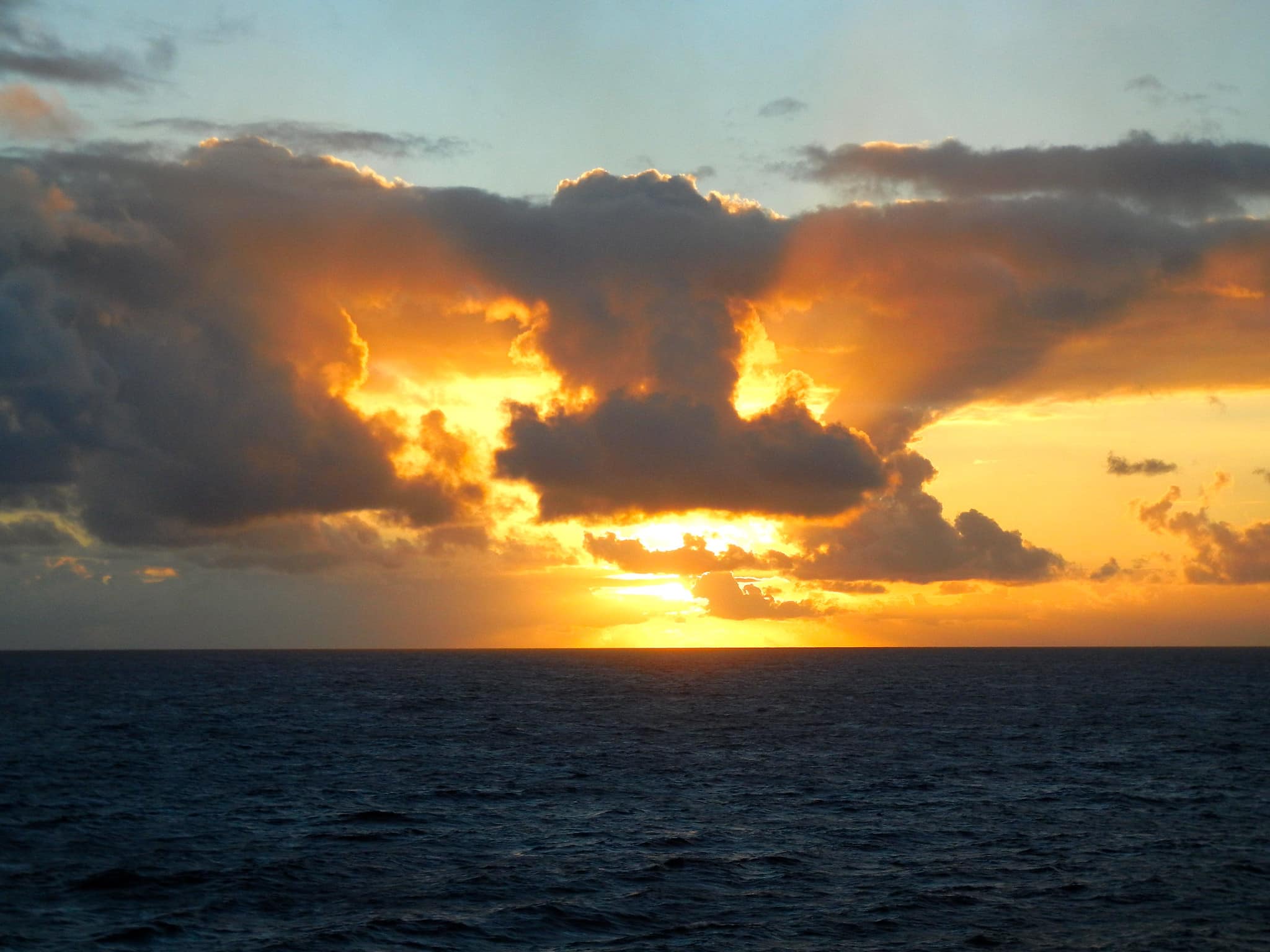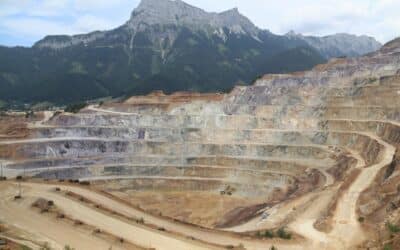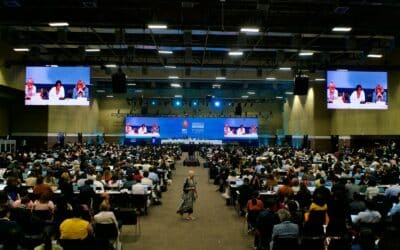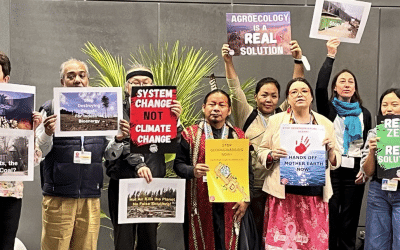We, civil society, Indigenous Peoples and grassroots organizations from around the world, are deeply concerned by the proliferation of open air and water marine geoengineering experiments that are planned or already underway, many of which are selling carbon offsets, in defiance of international agreements.
Increasingly, our oceans are at threat not only from the impacts of overexploitation and the climate crisis, but also from these misguided attempts to manipulate earth systems with the aim of countering some of the symptoms of climate change. The oceans’ vastness, vulnerability and comparatively pristine nature are still poorly understood, but they sustain life on earth and are our greatest ally in the fight against climate change: to misuse them in this way presents incalculable uncertainty and risk, and the effects of marine geoengineering on them are unpredictable.
Theoretical and experimental attempts at geoengineering in the marine environment currently include increasing the reflectivity of marine clouds or the ocean surface; marine carbon dioxide removal – dumping minerals or biomass in the ocean to increase carbon uptake, running electric currents through seawater, or pumping colder water from the deep ocean to the surface; and efforts to stop ice melt by spreading microbeads or pumping saltwater on its surface.
None of these technologies does anything to tackle the root causes of climate change; rather reliance on speculative technofixes delays vital action to cut greenhouse gasses. None have been able to demonstrate they can effectively sequester carbon or store it with any permanence, while efforts to cool the climate by increasing reflectivity are inherently unpredictable and risk further destabilizing an already destabilized climate system. It is highly likely that marine geoengineering would change the chemistry of oceans, cause changes in nutrient levels, and subsequent changes in abundance of species, thereby altering delicate equilibriums of interactions between species. [1,2]
We echo parties to the London Convention / London Protocol (LC/LP) who last year stated in relation to four key categories of marine geoengineering “there is considerable uncertainty regarding their effects on the marine environment, human health, and on other uses of the ocean”, and expressed concern about “the potential for deleterious effects that are widespread, long-lasting or severe”.
Despite the de facto moratorium on geoengineering under the Convention on Biological Diversity (CBD), in place since 2010, and the current process that may bring several additional categories of marine geoengineering under strict regulatory control under the London Convention / London Protocol (which already prohibit commercial ocean fertilization activities [3]), outdoor experiments in all of these categories have recently been carried out or are currently taking place, with many new experiments proposed.
While techniques vary considerably, what they share in common is the fact that to even begin to influence the global climate would require intervening at enormous scales, in highly complex and fragile ocean ecosystems. Ocean alkalinity enhancement, artificial upwelling, and ocean iron fertilization would theoretically require manipulating approximately 10% of the ocean’s surface for any meaningful climate impact. [4] However, even scales identified for ‘testing’ can be enormous with a now postponed marine cloud brightening trial proposing an experiment over an area of 10,000 sq km in the Pacific North East, [5] while a planned mega-farm of floating seaweed will grow modularly to reach 94,000 km² in the southern Atlantic – that is a larger area than that of Portugal. [6] Then there is the scale of associated infrastructure and transportation. In the case of ocean alkalinity enhancement, a massive increase in mining – with all its associated environmental and carbon impacts – would be required given that it theoretically takes approximately 2 tonnes of rock material to absorb 1 tonne of carbon. [7]
What many of these projects also have in common is carbon markets as a driving force, with start-ups running outdoor experiments selling or pre-selling commitments for carbon credits without any reliable evidence that they will ‘work’, and despite the fact that a commercial interest is a significant factor in putting them at odds with existing and emerging regulation. Any failure and leaks in the future would effectively cause a net increase of emissions. These companies also operate with little transparency regarding monitoring of either intended impacts or harmful consequences. Negotiations under Article 6 of the Paris Agreement risk legitimizing and entrenching these highly speculative, risky techniques.
Marine geoengineering additionally brings new risks to the livelihoods of Indigenous Peoples, traditional communities and fisherfolk who rely on marine and coastal ecosystems. The Human Rights Council report on the issue has found that climate altering technologies, including some marine geoengineering techniques, “could seriously interfere with the enjoyment of human rights for millions and perhaps billions of people” and that “the potential deployment of [geoengineering technologies] would have a massive and disproportionate impact on Indigenous Peoples whose traditional lands and territories are particularly exposed and at risk of experimental uses”. [8]
Geoengineering our oceans is a dangerous distraction from the real solutions to the climate crisis and gives the fossil fuel industry a potential escape hatch while putting our oceans and coastal communities at serious risk.
We therefore call on governments to:
- Prevent outdoor marine geoengineering experiments from taking place;
- Protect oceans, marine ecosystems and the communities and Indigenous Peoples that depend on them, including by upholding the precautionary principle, the right to Free Prior and Informed Consent, and the rights of access to information, public participation in decision making and access to justice;
- Uphold, enforce and strengthen the de facto moratorium under the Convention on Biological Diversity on all forms of geoengineering, in place since 2010;
- Support the development of strong precautionary regulatory controls under the London Convention / London Protocol on ocean alkalinity enhancement; biomass cultivation for carbon removal; marine cloud brightening; and surface albedo enhancement involving reflective particles and/or other materials, to be at least as stringent as those already in place for ocean fertilization;
- Urgently prioritize real solutions to the climate crisis by equitably phasing out fossil fuels and greenhouse gas emissions reduction, and supporting the many decentralized, diverse and readily available alternatives for socially and ecologically sustainable production and consumption patterns, including provision of climate finance by wealthy countries in accordance with their fair shares/equity.
[1] Russell LM, Rasch PJ, Mace GM, Jackson RB, Shepherd J, Liss P, Leinen M, Schimel D, Vaughan NE, Janetos AC, Boyd PW, Norby RJ, Caldeira K, Merikanto J, Artaxo P, Melillo J, Morgan MG. Ecosystem impacts of geoengineering: a review for developing a science plan. Ambio. 2012 Jun;41(4):350-69. doi: 10.1007/s13280-012-0258-5. Epub 2012 Mar 20. PMID: 22430307; PMCID: PMC3393062.
[2] https://www.oneearth.org/marine-geoengineering-a-dangerous-distraction-from-real-climate-action/
[3] Resolutions LC-LP.1(2008) and LC-LP.2(2010) provide the framework under which (i) ocean fertilization activities other than ‘legitimate scientific research’ are not allowed and (ii) commercial operations or other large-scale deployments are excluded from the definition of ‘legitimate scientific research’.
[4] High level review of a wide range of proposed marine geoengineering techniques.
[5] https://map.geoengineeringmonitor.org/srm/marine-cloud-brightening-project-(mcbp)
[7] https://www.geoengineeringmonitor.org/2021/04/enhanced-weathering-factsheet/
[8] A/HRC/54/47 Report of the Human Rights Council Advisory Committee on the Impact of new technologies intended for climate protection on the enjoyment of human rights, September 2023
Endorsements:
- AbibiNsroma Foundation
- Acción Ecológica, Ecuador
- Adéquations, France
- Afrihealth Optonet Association (AHOA)
- Alianza Biodiversidad América Latina
- Alianza por la Agrobiodiversidad, Colombia
- Amnesty International
- Animals Are Sentient Beings, Inc
- Asia Indigenous Peoples Network on Extractive Industries and Energy (AIPNEE)
- Asian Peoples’ Movement on Debt and Development (APMDD)
- Association For Promotion Sustainable Development, India
- Association KANDILI, Niger
- Association pour la Conservation et la Protection des Écosystèmes des Lacs et l’Agriculture Durable (ACOPELAD), DRC
- Biofuelwatch (BFW)
- BlueGreen, Coastal Resource Centre, Kerala India
- Carbon Market Watch
- CartoCrítica, Mexico
- Center for International Environmental Law (CIEL)
- Centre pour la Justice Environnementales Togo (CJE-Togo)
- Centro Ecológico, Brasil
- CESTA Friends of the Earth El Salvador
- CleanEarth4Kids.org
- Climate Action for Lifelong Learners (CALL), Canada
- Climate Justice Alliance (CJA)
- Climate Watch Thailand, Thailand
- Community Action For Health And Development (CAHED), Kenya
- Conexiones Climáticas, Mexico
- Congo Basin Conservation Society (CBCS Network), DRC
- Congo Basin Primary Forest Alliance (CBPFA)
- Continental Network of Indigenous Women of the Americas-ECM
- Corporate Accountability
- Corporate Europe Observatory (CEO)
- Deutsche Stiftung Meeresschutz
- Disability Peoples Forum, Uganda
- Dr Uzo Adirieje Foundation (DUZAFOUND)
- Durable (ACOPELAD), DRC
- EcoNexus
- ENGENERA (Energía, Género y Ambiente), México
- Environmental Investigation Agency (EIA)
- Equidad de Género, Ciudadanía, Trabajo y Familia, México
- Equidad de género: ciudadanía, trabajo y familia, México
- ETC Group
- European Environmental Bureau (EEB)
- Food & Water Action Europe
- Food & Water Watch
- Friends of the Earth International (FOEI)
- Friends of the Earth Japan
- Friends of the Earth Malta
- Friends of the Earth Scotland
- Friends of the Earth U.S.
- Fundación ProDefensa de la Naturaleza y sus Derechos
- Global Forest Coalition (GFC)
- Global Justice Ecology Project
- GlobalChoices, USA/UK
- Grassy Hills Center for Holistic – Wellbeing and Empowerment Foundation
- GreenLatinos
- Group for the Development of Women and Girls – GDMR, Mozambique
- Grupo Semillas, Colombia
- Health of Mother Earth Foundation (HOMEF)
- Heinrich Boell Foundation (hbf)
- Human Environmental Association for Development (HEAD)
- Indian Confederation of Indigenous and Tribal Peoples (ICITP)
- Indian Point Safe Energy Coalition
- Indigenous Environmental Network (IEN)
- Institute for Policy Studies Climate Policy Program
- Just Transition Alliance
- Justiça Ambiental/ Friends of the Earth Mozambique
- Keepers of the Water
- Les Amis de la Terre-Togo
- Memphis Community Against Pollution
- National Fishworkers Forum (India)
- Network of youth organizations engaged in climate change, biodiversity conservation, wetlands and forests in DRC
- NOAH Friends of the Earth Denmark
- Nuclear Energy Information Service (NEIS), Chicago IL
- Occupy Bergen County, New Jersey, USA
- Ocean, Coastal and Ecological Alliance Network (O.C.E.A.N)
- OceanCare
- Office against Discrimination, Racism and Intolerance (ODRI)
- Oil and Gas Action Network
- Physicians For Social Responsibility Pennsylvania
- Port Arthur Community Action Network (PACAN)
- Red de Coordinación en Biodiversidad
- Reforest The Earth, UK
- Regional Advocacy for Women’s Sustainable Advancement (RAWSA)
- RISE for Environmental Justice (RISE4EJ)
- Santa Fe Forest Coalition, USA
- Sciaena – Ocean # Conservation # Awareness
- Scientists for Global Responsibility, UK
- Seas At Risk
- Servicios Ecumenicos para Reconciliacion y Reconstrucction, USA
- Société Civile environnementale et Agro Rural du Congo SOCEARUCO Sud Kivu, DRC
- Society for Conservation and Sustainability of Energy and Environment in Nigeria (SOCSEEN)
- Terra Advocati, Texas, USA
- The Gaia Foundation
- The Hoodwinked Collective
- The Pacific Network on Globalisation (PANG)
- Third World Network (TWN)
- TONATIERRA
- Turtle Island Restoration Network
- UBINIG (Policy Research for Development Alternative), Bangladesh
- Village Farmers Initiative (VFI), Nigeria
- WECF International – Women Engage for a Common Future
- Whale and Dolphin Conservation (WDC)
- WhatNext?
- Women’s Environment and Development Organization (WEDO)
- Women’s International League’s of Peace and Freedom (WILPF) UK
- 350 Mass



